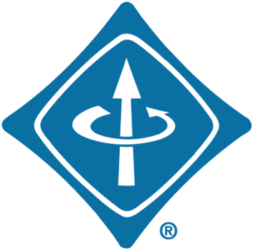DISTINGUISHED TALKS

We are pleased to invite you to the webinar “Cryo-CMOS Quantum-Classical Interfaces to Quantum Processors: from a Wild Idea to Working Silicon” held by Prof. Edoardo Charbon from École Polytechnique Fédérale de Lausanne (EPFL), Switzerland. The event will take place on July 12th at 9.30 AM in the Magenta Seminar room (D floor) at the Dept. of Electrical, Computer and Biomedical Engineering of the Faculty of Engineering .
Thank you and best wishes from the IEEE Student Branch of Pavia and PESB.
Edoardo Charbon (SM’00 F’17) received the Diploma from ETH Zurich, the M.S. from the University of California at San Diego, and the Ph.D. from the University of California at Berkeley in 1988, 1991, and 1995, respectively, all in electrical engineering and EECS. He has consulted with numerous organizations, including Bosch, X-Fab, Texas Instruments, Maxim, Sony, Agilent, and the Carlyle Group. He was with Cadence Design Systems from 1995 to 2000, where he was the Architect of the company’s initiative on information hiding for intellectual property protection. In 2000, he joined Canesta Inc., as the Chief Architect, where he led the development of wireless 3-D CMOS image sensors. Since 2002 he has been a member of the faculty of EPFL, where he is full professor. From 2008 to 2016 he was with Delft University of Technology’s as full professor and Chair of VLSI design. He has been the driving force behind the creation of deep-submicron CMOS SPAD technology, which is mass-produced since 2015 and is present in telemeters, proximity sensors, and medical diagnostics tools. His interests span from 3-D vision, LiDAR, FLIM, FCS, NIROT to super-resolution microscopy, time-resolved Raman spectroscopy, and cryo-CMOS circuits and systems for quantum computing. He has authored or co-authored over 450 papers and two books, and he holds 25 patents. Dr. Charbon is the recipient of the 2023 IISS Pioneering Achievement Award, he is a distinguished visiting scholar of the W. M. Keck Institute for Space at Caltech, a fellow of the Kavli Institute of Nanoscience Delft, a distinguished lecturer of the IEEE Photonics Society, and a fellow of the IEEE.
The core of a quantum processor is generally an array of qubits that need to be controlled and read out by a classical processor. This processor operates on the qubits with nanosecond latency, several millions of times per second, with tight constraints on noise and power dissipation. This is due to the extremely weak signals from the processor that require highly sensitive circuits and systems, along with very precise timing capability. We advocate the use of CMOS technologies to achieve these goals, whereas the circuits will be operated at deep-cryogenic temperatures. We believe that these circuits, collectively known as cryo-CMOS control, will make future qubit arrays scalable, enabling a faster growth in qubit count. In this session, the challenges of modeling, designing, and operating complex circuits and systems at 4K and below will be outlined, along with preliminary results achieved in the control and read-out of qubits by ad hoc integrated circuits that were optimized to operate at low power in these conditions. We will conclude with a perspective on the field and its trends.

We are pleased to invite you to the webinar “Brain Stroke Microwave Imaging” held by Prof. Francesca Vipiana from Politecnico di Torino. The event will take place on June 4th at 10.00 AM in the Magenta Seminar room (D floor) at the Dept. of Electrical, Computer and Biomedical Engineering of the Faculty of Engineering .
Thank you and best wishes from the IEEE Student Branch of Pavia and PESB.
Francesca Vipiana is a Full Professor of Electromagnetic Fields at the Department of Electronics and Telecommunications of the Politecnico di Torino, Torino, Italy. Her current research interests include the modelling, design and testing of microwave imaging and sensing systems for medical and industrial applications. She is also involved in the development of numerical techniques based on integral equations and method of moment approaches, with a focus on multiresolution schemes, domain decomposition and advanced quadrature integration schemes. Prof. Vipiana received the Young Scientist Award from the Union of Radio Science General Assembly (URSI) in 2005, the First Prize in the poster competition at the IEEE Women in Electromagnetics Workshop in 2009, the ISMB Best Paper Award in 2011, the Lot Shafai Mid-Career Distinguished Award from the IEEE Antennas and Propagation Society (APS) in 2017, and the Best Paper Award at the Spanish URSI Symposium in 2023. She is currently Associate Editor of the IEEE Transactions on Antennas and Propagation, Associate Editor of the IEEE Antennas and Propagation Magazine, where she is the responsible for the column “Women in Engineering”, Vice-Chair of the IEEE APS Diversity, Equity, Inclusion and Belonging Committee, and part of the Board of Directors in the European Association on Antennas and Propagation (EurAAP).
Microwave imaging is a technology able to exploit differences in dielectric properties (i.e., permittivity and conductivity) of objects illuminated with an array of antennas at low-power microwave frequencies in order to identify unknown targets in a known scenario. This technology has several attractive characteristics such as it is non-destructive, contactless, totally safe for operators, potentially real-time, cost-efficient and easy to operate. On the other side there are some intrinsic constraints: the dielectric contrast between the targets and the surrounding media, and the needed wave spatial resolution and penetration depth within the considered media. In this seminar, the key ingredients to model, design, realize and test microwave imaging systems will be presented, including an ad-hoc problem-based design procedure, a reliable and effective forward solver, model-based imaging techniques and specialized hardware. Here, the proposed microwave system is designed for the medical continuous monitoring of patients after the stroke onset. The developed prototypes will be presented and discussed highlighting their capabilities with respect to the current state of the art.

We are pleased to invite you to the webinar “Microwave Applications for Snow Monitoring: from theory to practice” held by Guido Luzi, PhD and Pedro Espín-López, PhD, from Centre Tecnològic de Telecomunicacions de Catalunya (CTTC). The event will take place on May 29th at 9.00 AM in Aula Ricciardi (at the Dept. of Civil Engineering and Architecture) of the Faculty of Engineering .
Thank you and best wishes from the IEEE Student Branch of Pavia and PESB.
– Massimo Di Fabrizio got his Master’s degree in Electronic Engineering from the University of Ancona with a thesis on a 2-5GHz broadband transceivers in planar technology and his PhD in Materials, Waters and Soils Engineering from the Università Politecnica delle Marche defending his thesis on Liquid Crystals (CL) for the correction of optical aberrations and the design of a reconfigurable plasma antenna (Gas Antenna). Massimo Di Fabrizio has more than 15-years’ experience in the design of RF active components (power amplifiers based on LDMOS and GaN technology, up/down converters, antennas) as well as gained industrial competences on product testing and commissioning. He is currently working as a RF Senior Engineer in Thales Italy, Gorgonzola (MI) site
– Luigi Maggi got his Master’s degree in Electronic Engineering from the “La Sapienza” – University of Rome with a thesis on the “Design of driving system controller based on FPGA technology” and his PhD in Telecommunication from Politecnico di Milano defending his thesis on Azimuth Digital Beamforming techniques and the study of new solutions for multichannel architecture for image SAR. Luigi Maggi has more than 10-years’ experience in Sensors and Radar systems for industrial, mining and military field of applications. In particular, he has been for many years the leader of the hardware design and development of interferometric single channel and MIMO Radars operating at different frequency bands (V, W, K) as well as Radar benchmarking equipment to support system ground testing activities. He is currently working as Hardware Manager for Electronic Engineering and Hardware Architect for Navaids products in Thales Italy, Gorgonzola (MI) site.
Air traffic has consistently grown since 2003 and it is now boosting up in 2023, prompting a need for aviation authorities to upgrade their ATC systems. Thales group developed comprehensive solutions for busy airports, covering various flight phases. After a quick introduction to Thales Group, its activities in Italy and the conventional navigational aids (Navaids) business for which Gorgonzola (MI) site is a center of excellence for the Group, the speakers will finally focus on the design of pulsed power amplifiers that achieve stringent spectral requirements, discussing both squared pulse modulation scheme and envelop tracking.

We are pleased to invite you to the webinar “Celebrating the Day of Light: Miracle Light! ” held by Prof. Silvano Donati from University of Pavia. The event will take place on May 16th at 11.00 AM in the Magenta Seminar Room (D floor) of the Faculty of Engineering and from remote (via Zoom).
Thank you and best wishes from the IEEE Student Branch of Pavia.
Silvano Donati is an Emeritus Professor of University of Pavia since 2015, after having been Full Professor for 31 years. He has fostered the activities and grown a research Group in Optoelectronics at his Alma Mater. Under his guidance 23 PhD students and 125 Master’s have been graduated. Has published two books, Photodetectors and Photonics Instrumentation, plus 350+ papers in ISI Journals and 12 patents. He is an IEEE Life Fellow and an Optica Emeritus Fellow. He has been Visiting Professor in several Universities of Taiwan (NTU, NSYSU, NCKU, NCHU, NTUT) and presently is carrying out research at NTUST (Taipei).
The Day of Light is an official celebration of UNESCO following the success of the 2015 Year-of-Light. In this talk we will first illustrate how light is a miracle permeating science and culture, technology and biology. Then we exemplify the applications considering two very basic fields: Photodetection (supplying us with devices for wavelength range from UV to FIR and Terahertz waves, and also single photon detectors, and ultrafast detectors), and Photonics Instrumentation (particle size sensing, rangefinders and LiDARs, interferometers for industrial measurements and Optical Coherence Tomography for biomedicine, laser and fiberoptic gyroscopes for inertial navigation, and Laser Doppler Velocimeters).

We are pleased to invite you to the webinar “An Overview On The Design Of Pulsed Power Amplifiers For Conventional Navigational Aids Systems” held by Ing. Massimo Di Fabrizio, PhD and by Ing. Luigi Maggi, PhD, from THALES ITALY. The event will take place on December 20th at 2.00 PM in the Magenta Seminar Room (D floor) of the Faculty of Engineering .
Thank you and best wishes from the IEEE Student Branch of Pavia and PESB.
- Guido Luzi graduated in Physics and holds a PhD in Electronic Systems Engineering. He has been working since 1986 in microwave remote sensing, active and passive, both in industrial and research institutions, dedicating his work to the development and experimentation of microwave sensors. He was involved in several international remote sensing campaigns as AGRISCATT87, AGRISCATT88, MACEurope, EPOCH, MEDALUS II, ENVIRONMENT, GALAHAD and several national research contracts. He worked for the Department of Electronics and Telecommunications and the Department of Earth Sciences of the University of Florence, working on various applications from monitoring volcanic areas as the Stromboli Island, to the development and experimentation of microwave sensors for the detection of vital signs (heart beat and breath), or Civil Engineering and Cultural Heritage applications. He moved to the Institute of Geomatics in 2010, where he was involved in the design and experimentation of radar-based sensing techniques with emphasis on GB-SAR interferometry. He has mainly focused his interest towards geophysical applications, with emphasis in the observation of landslides through terrestrial and satellite microwave interferometry and civil structures monitoring. He has authored or co-authored many papers in international journals concerning the aforementioned topics, and published more than sixty papers in referred international journals. He acts as referee for different journals: IEEE Trans. On Geoscience and Remote Sensing, IEEE Geoscience Remote Sensing Letters, Int. Jour. of Remote Sensing, IEEE Selected Topics in Applied Earth Observations. He is with the Remote Sensing Department (Geomatics Division) of the CTTC since January 2014, where he is involved in research activities concerning the application of spaceborne and terrestrial radar techniques.
- Pedro Espín-López was born in Murcia, Spain, in 1989. He received the M.S. degree in electronic engineering from the Technical University of Cartagena, Spain, in 2015. During 2015-2016 he worked with the European Institute of Oncology (IEO) as research fellow. His work was focused on the study of non-ionizing dosimetry and the assessment of safety for a breast cancer detection system using millimetre and sub-millimetre waves. In 2020, he received the Ph.D. in electronics from the University of Pavia thanks to his research activities on the study and development of microwave and millimetre wave radar systems, paying special attention to the monitoring of the snow cover. Currently he is working at the Centre Tecnològic de Telecomunicacions de Catalunya (CTTC) as Researcher in the Geomatics Research Unit.
Snow is a very important environmental variable and a primary water resource in many areas of the world. Monitoring seasonal snowpack properties is crucial for properly managing snow-related hazards such as snow avalanches and snowmelt-floods. Microwave radars have been proposed as a mean to non-destructively monitor snowpacks, but they face several problems. From the electromagnetic point of view, snow is a complex material that can change its electromagnetic properties within seconds. Moreover, it is almost impossible to be studied inside a laboratory and some of the sites for studying the snow in good conditions can be hard-to-reach and with adverse meteorological conditions. All these aspects make the study of snow a real challenge. This seminar will focus on the techniques to study the snow using microwaves and how these techniques are applied in the field.
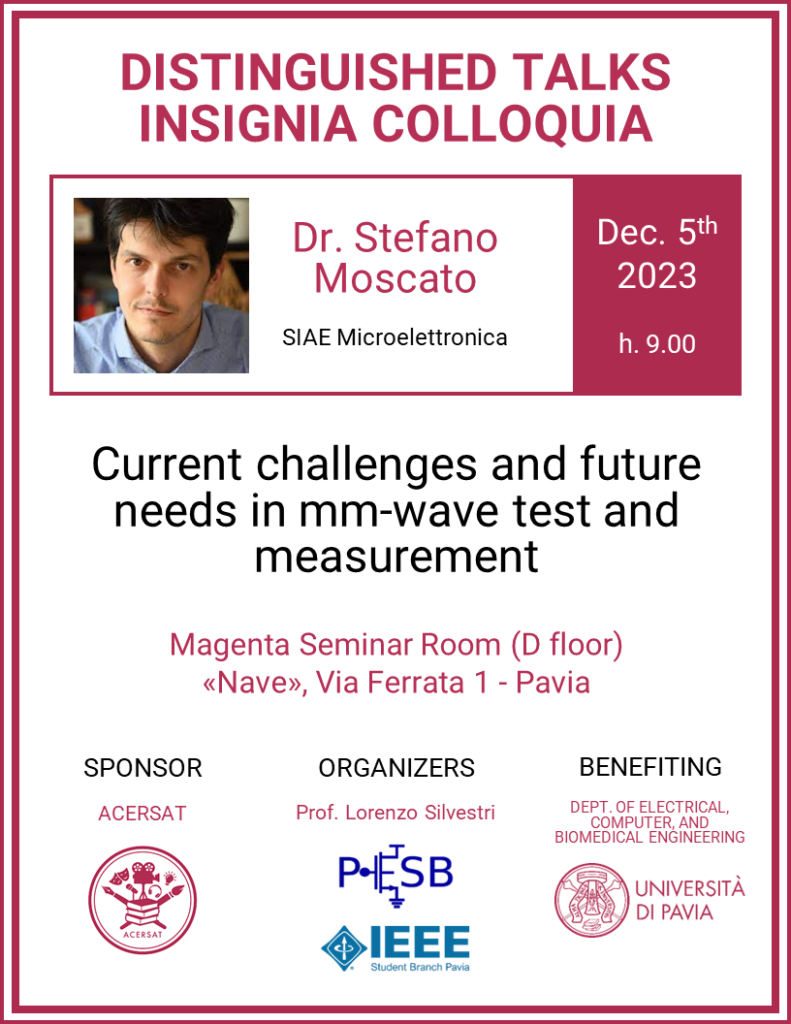
We are pleased to invite you to the webinar “Current challenges and future needs in mm-wave test and measurements” held by Dr. Stefano Moscato, from SIAE Microelettronica. The event will take place on December 5th at 9.00 AM in the Magenta Seminar Room (D floor) of the Faculty of Engineering .
Thank you and best wishes from the IEEE Student Branch of Pavia and PESB.
Stefano Moscato was born in Pavia, Italy in 1988. He received the Ph.D. degree in electronics engineering from the University of Pavia, Italy, in 2016. He was a visiting Ph.D. student at Georgia Tech, Atlanta, GA, USA, in early 2015. He became part of the R&D microwave group of SIAE MICROELETTRONICA in May 2017. His research activities have been focused on RF-to-mm-wave passive components. From September 2022, Dr. Moscato is the head of the 1337 R&D group devoted to the design and validation of mm-wave passive components, antennas and sub-systems. He is involved in innovation programs and founded researches for microwave backhauling, O-RAN equipment, and space-oriented assemblies. He was a recipient of an IEEE MTTS Undergraduate/Pre-Graduate Scholarship in 2012, author of more than 50 papers on international journals and conferences. He has been the Chair of the IEEE Student Branch, University of Pavia, from 2013 to 2016.
The spectrum portion above 60 GHz is gaining importance year by year mainly driven by the upcoming Beyond-5G and 6G paradigms. In the terrestrial scenario, the E-band (71-86 GHz) currently offers the widest channels for point-to-point (P2P) wireless links but future perspectives already foresee the D-band (130-175 GHz) as the next step in the backhauling deployment. Systems for the detection of space debris and high-speed space data links, instead, heavily rely on W-band, which spans from 75 to 110 GHz. To keep pace with these applications, high-performance active components, passives and antennas are urgently needed. The design of such systems is only part of the job of engineers: once the prototype has been manufactured, the DUT validation is mandatory to deliver a working and reliable product with the intended performance. In the mm-wave spectrum, the lack of standard commercial devices leads to the necessity of custom testing socket, transitions, mechanical assembly, far-field setup, which have to be carefully designed to primary privilege measurement accuracy and avoid any performance drop. This seminar will cover the validation aspects of mm-wave systems, starting from the MMIC, to the passive waveguide assembly and mm-wave high-gain antennas.
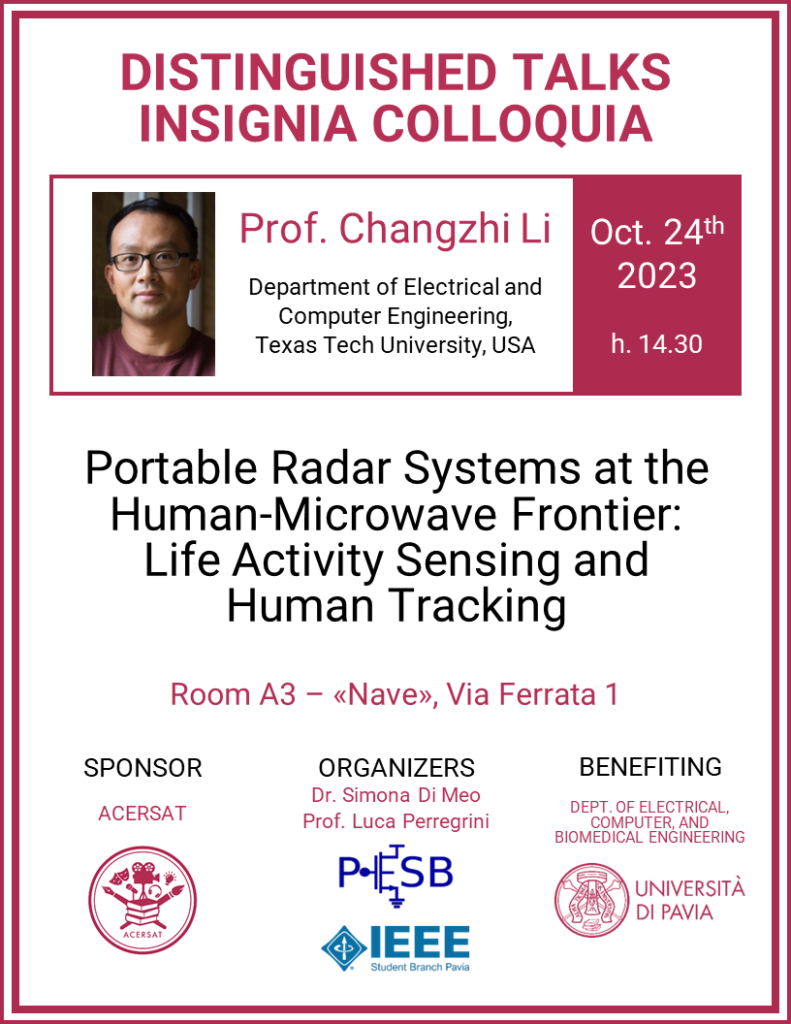
We are pleased to invite you to the webinar “Portable Radar Systems at the Human-Microwave Frontier: Life Activity Sensing and Human Tracking” held by Changzhi Li, professor at the Department of Electrical and Computer Engineering of the Texas Tech University (USA). The event will take place on October 24th at 2.30 PM in A3 Room of the Faculty of Engineering .
Thank you and best wishes from the IEEE Student Branch of Pavia and PESB.
Changzhi Li received a Ph.D. degree in Electrical Engineering from the University of Florida, Gainesville, FL in 2009. He is a Professor at Texas Tech University. His research interest is microwave/millimeter-wave sensing for healthcare, security, and human-machine interface.Dr. Li is an MTT-S Distinguished Microwave Lecturer. He was a recipient of the IEEE MTT-S Outstanding Young Engineer Award, the IEEE Sensors Council Early Career Technical Achievement Award, the IEEE-HKN Outstanding Young Professional Award and the ASEE Frederick Emmons Terman Award. He is the General Chair of the 2024 IEEE Radio & Wireless Week (RWW), and an Associate Editor of the IEEE JOURNAL OF ELECTROMAGNETICS, RF AND MICROWAVES IN MEDICINE AND BIOLOGY. He served as the chair of the MTT-S Technical Committee “Biological Effect and Medical Applications of RF and Microwave” from 2018 to 2019, the TPC Chair of the 2022 IEEE RWW, a TPC Co-Chair of the IEEE MTT-S International Microwave Biomedical Conference (IMBioC) from 2018 to 2019, and the TPC Chair of the IEEE Wireless and Microwave Technology Conference from 2012 to 2013. He is a Fellow of the National Academy of Inventors.
By sensing various life activities with microwave signals, portable radar with state-of-the-art front-end and measurement algorithms has great potential to improve healthcare, security, and human-machine interface. This presentation will first provide an overview of the state-of-the-art smart radar sensors powered by advanced digital/RF beamforming, multiple-input and multiple-output (MIMO), inverse synthetic-aperture radar (ISAR) technique, and deep learning. A few examples based on interferometry, Doppler, frequency-shift keying (FSK), and frequency-modulated continuous-wave (FMCW) modes at 5.8 GHz, 24 GHz, and 120 GHz will be discussed. In addition, the use of nonlinear technologies will be reported, with a focus on in-band third-order intermodulation measurement for enhanced target identification and parameter extraction. Case studies at this exciting human-microwave frontier will be presented on physiological signal sensing, non-contact human-computer interface, driving behavior recognition, human tracking, and studies in clinical environments. Finally, this talk will conclude with future industrial and academic R&D outlooks for microwave short-range life activities sensing.
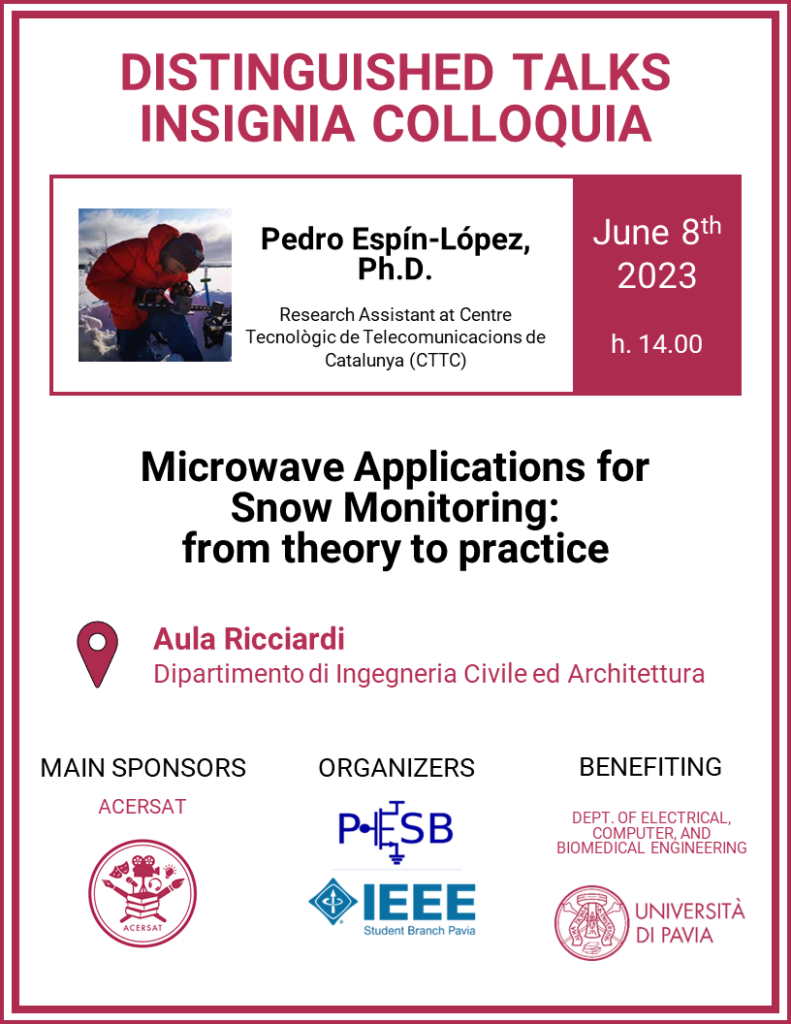
We are pleased to invite you to the webinar “Microwave Applications for Snow Monitoring: from theory to practice” held by Pedro Espin-Lopez, Ph.D., research assistante at Centre Technologic de Telecommunications de Catalunya (CTTC). The event will take place on June 8th at 2.00 AM in Aula Ricciardi of the Department of Civil Engineering and Architecture.
Thank you and best wishes from the IEEE Student Branch of Pavia and PESB.
Pedro Espín-López was born in Murcia, Spain, in 1989. He received the M.S. degree in electronic engineering from the Technical University of Cartagena, Spain, in 2015. During 2015-2016 he worked with the European Institute of Oncology (IEO) as research fellow. His work was focused on the study of non-ionizing dosimetry and the assessment of safety for a breast cancer detection system using millimetre and sub-millimetre waves. In 2020, he received the Ph.D. in electronics from the University of Pavia thanks to his research activities on the study and development of microwave and millimetre wave radar systems, paying special attention to the monitoring of the snow cover. Currently he is working at the Centre Tecnològic de Telecomunicacions de Catalunya (CTTC) as Researcher in the Geomatics Research Unit.
Snow is a very important environmental variable and a primary water resource in many areas of the world. Monitoring seasonal snowpack properties is crucial for properly managing snow-related hazards such as snow avalanches and snowmelt-floods. Microwave radars have been proposed as a mean to non-destructively monitor snowpacks, but they face several problems. From the electromagnetic point of view, snow is a complex material that can change its electromagnetic properties within seconds. Moreover, it is almost impossible to be studied inside a laboratory and some of the sites for studying the snow in good conditions can be hard-to-reach and with adverse meteorological conditions. All these aspects make the study of snow a real challenge. This seminar will focus on the techniques to study the snow using microwaves and how these techniques are applied in the field.

We are pleased to invite you to the webinar “The Alps are turning green” held by our treasurer Dott.ssa Martina Lodigiani, Ph.D. student of the University of Pavia. The event will take place on May 19th at 11.00 AM in Magenta Seminar Room of the Faculty of Engineering and online.
The event is co-organized with the associations AMES and AEIT.
Thank you and best wishes from the IEEE Student Branch of Pavia and PESB.
Martina received the bachelor’s degree in Electronic and Computer Engineering in July 2018 from the University of Pavia with a thesis concerning the analysis of the link budget of a satellite link in polar environment, in the framework of the ESA’s project “SNOWBEAR”. Then, she also received the master’s degree in Electronic Engineering – Space Communication and Sensing in November 2020. The MS thesis has been developed in collaboration with the Finnish Meteorological Institute (FMI), Helsinki (FI), working on a radar system for the monitoring of the electrical properties of different snowpacks. From November 2020, she is working as a PhD student at the Microwave Laboratory of the University of Pavia as a researcher in snowpack monitoring by means of radar systems. During winter 2022/2023, Martina was a Guest Researcher at the Nano Group of the Universitetet i Oslo (UiO), where she worked with a commercial UWB radar applied on snowpack monitoring. She was the principal researcher in ARCTIC-GBR and RADARC, two projects founded by EU Horizon 2020, for monitoring the melting phase of seasonal snow in polar regions. She recently got the title of “Snow Expert” from the Interregional Association for coordination and documentation of snow and avalanche problems AINEVA.
The changes in the climate condition of our planet are increased in the latest years, and they are particularly visible in critical environment such as the Alps. The rising of the temperatures contributes to the melting of the glaciers and of the seasonal snow coverage, turning our mountains from white to green even during winter. The effect of this change is visible in several fields, and the human being is the seriously affected. Fresh water supply, hydroelectrical power generation and avalanches are only few issues coming from the shortage of these important resources. To monitor this condition and, when possible, to prevent damages, several technologies are used. Among them, radars are valuable instruments with high accuracy and easy to use.

We are pleased to invite you to a webinar on SatCom On-the-move Antennas held by Marco Formaggi, Ph.D. of A.D.S. International. The event will take place on January 20th at 11.00 AM in E4 room of the Faculty of Engineering.
Thank you and best wishes from the IEEE Student Branch of Pavia and PESB.
Marco Formaggi was born in Novara in 1978. He received the MSc degree in Electronics Engineering and the PhD degree in Electronics from the University of Pavia in 2003 and 2007, respectively. In the 2002-2004 timeframe he was first a trainee and then a Callisto Space contractor at the European Space Agency ESA/ESOC in Darmstadt, Germany, where he was supporting the Ground Station Segment design activities. After a brief experience as Business Analyst with Arthur D. Little, in 2008 Marco joined Cobham, UK where he worked from 2008 to 2013 initially as antenna Design Engineer and then as Project Manager/Team Leader. From 2013 to 2015 he took the role of Defence and Telecommunications Sales Manager for the Italian field office of CPI – Communications and Power Industries, covering the Southern European market. Marco is currently employed as Business Development Manager at A.D.S. International, where he is developing the new Satcom and Defence business line (https://www.ads-int.com/satcom-defense).
In a world that is more interconnected every day, being on-line at any given moment is becoming essential for all applications and particularly for those where it is of paramount importance to receive or send the right information at the right time. When the main communication infrastructure is severely damaged, unsafe, unreliable or unavailable, satellite communications may be the only viable solution. In adverse conditions, being able to establish a satellite link while on the move, provides a higher degree of flexibility and a clear strategic advantage. The advances in RF engineering allowed in recent years a flourishing of the satcom on the move technology, however several research and development aspects need to be successfully addressed to fully meet all the application requirements. This seminar will address the current R&D trends in the field of “on-the-move” satellite communication, with an emphasis on the antenna and positioner technologies.
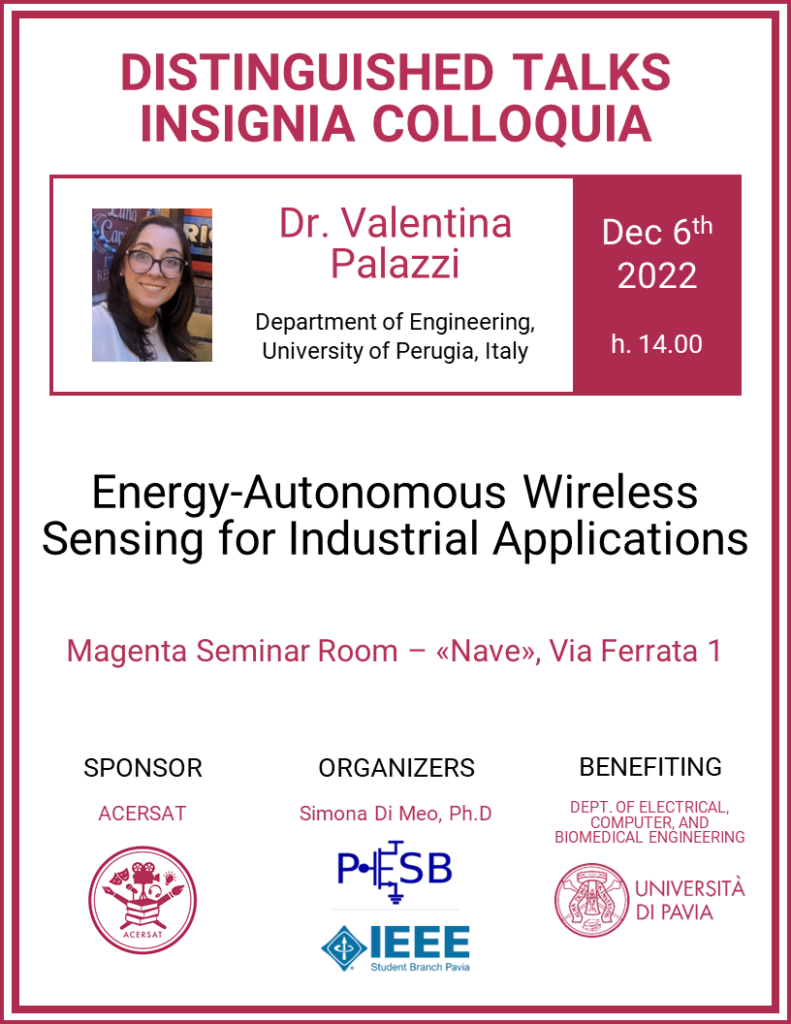
We are pleased to invite you to a webinar on Energy-Autonomous Wireless Sensing for Insustrial Applications held by Dr. Valentina Palazzi of the Department of Engineering of the University of Perugia, Italy. The event will take place on December 6th at 14.00 am in Magenta Seminar Room of the Faculty of Engineering.
Thank you and best wishes from the IEEE Student Branch of Pavia and PESB.
VALENTINA PALAZZI received the M.S. degree in electrical engineering and the Ph.D. degree in industrial and information engineering from the University of Perugia, Italy, in 2014 and 2018, respectively. In 2015 she was a Visiting Ph.D. Student with the Tyndall National Institute, Cork, Ireland; in 2016 she did a short-term scientific mission with the Centre Tecnologic de Telecomunicacions de Catalunya, Barcelona, Spain, sponsored by the cost action IC1301 “WiPE”; from December 2016 to April 2017 she was a student intern with the Agile Technologies for High- Performance Electromagnetic Novel Applications Research Group, School of Electrical and Computer Engineering, Georgia Institute of Technology, Atlanta, GA, USA. Since 2019, she has been a researcher at the Department of Engineering, University of Perugia, Italy. She has co-authored more than 50 articles, and holds 3 patents. Her current research interests include the design of RF components, wireless sensors, radar front ends, wireless power transfer technologies, additive manufacturing processes, and conformal electronics. Dr. Palazzi is chair of the IEEE Microwave Theory and Technique Society (MTT-S) Technical Committee- 26 “RFID, Wireless Sensor and IoT”, and is Early Carrer Representative of the Commission D “Electronics and Photonics” of the International Union of Radio Science (URSI).
Wireless sensors are ever more adopted in industrial environments to check the correct operation of machines, and to verify the structural integrity of equipment and infrastructures in real time. This way, anomalies can be detected at an early stage, thereby reducing production waste and improving safety. A drawback in the use of wireless sensors is their power supply: sensors are usually embedded in machines and powered using batteries, which must be periodically replaced. This is unacceptable in many industrial scenarios, where the machineries and the related sensors must operate without interruptions, and where sensors are usually placed in remote areas. This talk focuses on describing emerging approaches for wireless sensing in industrial environments, which allow us to achieve seamless operation of the sensors, without any battery change. Special attention will be paid to harmonic transponders. These tags leverage harmonic backscattering for communication, are robust to clutter and are ultra low power, which makes them particularly appealing for industrial environments. Application-oriented solutions, based on ultra low power and passive transponders, will be described, and the main trade-offs and challenges to the development of energy-autonomous systems will be discussed.

We are pleased to invite you to a webinar on Challenges in mm-wave test and measurement: from the device to the product held by Dr. Stefano Moscato of SIAE Microelettronica. The event will take place on December 1st at 11.00 AM in E7 room of the Faculty of Engineering.
Thank you and best wishes from the IEEE Student Branch of Pavia and PESB.
Stefano Moscato was born in Pavia, Italy in 1988. He received the Ph.D. degree in electronics engineering from the University of Pavia, Italy, in 2016. He was a visiting Ph.D. student at Georgia Tech, Atlanta, GA, USA, in early 2015. He became part of the R&D microwave group of SIAE Microelettronica in May 2017. His research activities have been focused on RF-to-mm-wave passive component. From September 2022, Dr. Moscato is the head of the 1337 R&D group devoted to the design and validation of mm-wave passive components, antennas and sub-systems. He is involved in innovation programs and founded researches for microwave backhauling, O-RAN equipment, and space-oriented assemblies. He was a recipient of an IEEE MTTS Undergraduate/Pre-Graduate Scholarship in 2012, author of more than 40 papers on international journals and conferences. He has been the Chair of the IEEE Student Branch, University of Pavia, from 2013 to 2016.
The spectrum portion between 60 and 110 GHz is gaining importance year by year mainly driven by the 5G paradigm. In the terrestrial scenario, V-band (40-75 GHz) is suitable for short-range communications while E-band (71-86 GHz) offers the widest channels for point-to-point (P2P) wireless links. Systems for the detection of space debris and high-speed space data links, instead, heavily rely on W-band, which spans from 75 to 110 GHz. To keep pace with these applications, high-performance components with enhanced reliability are urgently needed. The design of such systems is only part of the job of engineers: once the prototype has been manufactured, the DUT validation is mandatory to deliver a working product with the intended performance. In the mm-wave spectrum, the lack of standard commercial devices leads to the necessity of custom testing socket, transitions and mechanical assembly, which have to be carefully designed to primary privilege measurement reliability and avoid any performance drop. This seminar will cover the validation aspects of mm-wave systems, starting from the MMIC, to the waveguide assembly, to the final carrier-grade product.
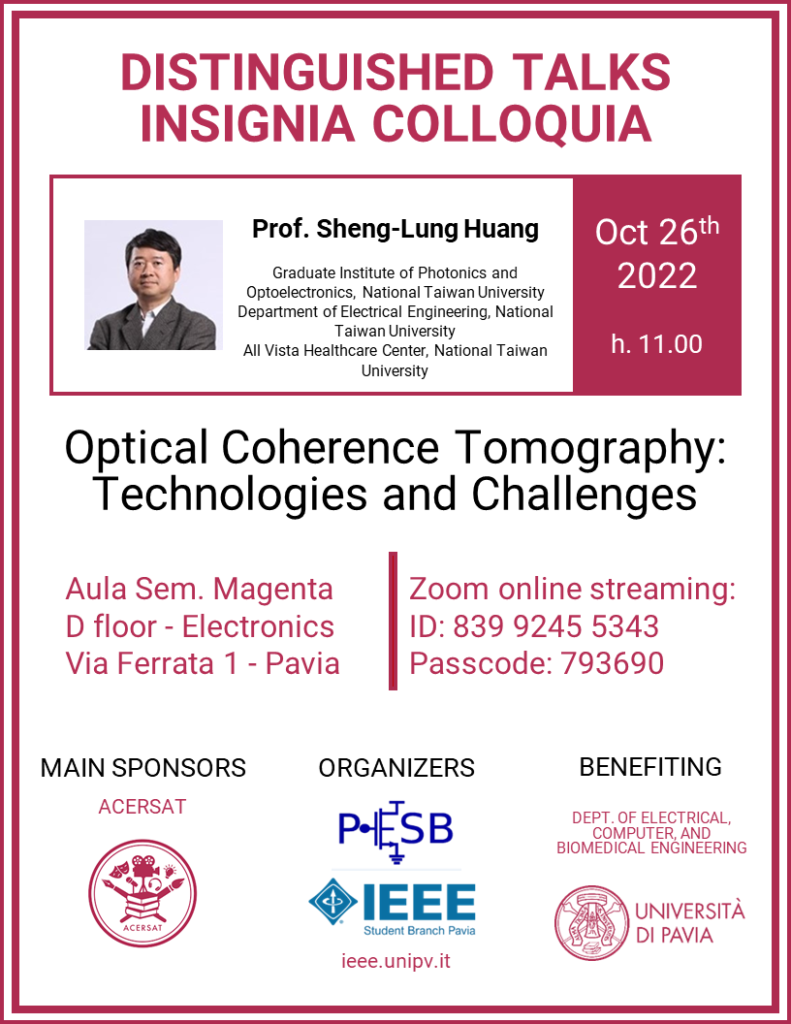
We are pleased to invite you to a webinar on Optical Coherence Tomography: Technologies and Challenges held by Prof. Sheng-Lung Huang of the National Taiwan University. The event will take place on October 26th at 11.00 am in Magenta Seminar Room of the Faculty of Engineering and online.
Thank you and best wishes from the IEEE Student Branch of Pavia and PESB.
Dr. Sheng-Lung Huang received his Ph.D. from the Department of Electrical Engineering, University of Maryland, College Park, in 1993. He is a Distinguished Professor at the Graduate Institute of Photonics and Optoelectronics (GIPO) and the Department of Electrical Engineering, National Taiwan University. He served as the Chairman of GIPO from 2007 to 2010. He was also a guest professor at the Abbe School of Photonics, Friedrich-Schiller University of Jena, Germany, in 2014. Dr. Huang is a Fellow of the Optica. He pioneers the development of cellular-resolution optical coherence tomography and has used it clinically in the early-stage diagnosis of cancers and diseases. In 2014, he co-founded Apollo Medical Optics and was the Chief Technology Officer. Dr. Huang served as Chairman of IEEE/LEOS (now IEEE/PS) Taipei Chapter from 2005 to 2006. He was a steering board member of the European Master of Science in Photonics (EMSP). Dr. Huang served as an Associate Editor of the IEEE Photonics Journal and was a Topical Editor, Optics Letters, 2005–2011. Dr. Huang has received the Outstanding Research Award from the Ministry of Science and Technology and the University/Industry Cooperation Award from the Ministry of Education, Taiwan. He has also received Chimei Innovation Excellence Award and Optical Communications Elite Award.
Optical coherence tomography (OCT) has now become a standard of care, impacting the treatment of millions of people every year. There is tremendous clinical and preclinical OCT progress in diagnosing cancers and disorders in ophthalmology, cardiology, dermatology, gastroenterology, etc. In recent years, OCT technologies have been advancing rapidly in cross-sectional and en-face imaging speeds, spatial resolutions, and functionalities due to breakthroughs in broadband light sources and various micro-optical probes for reaching deep and interior tissues and organs. Dynamic anatomical variations can also be assessed on a time scale beyond milliseconds. Morphological recognition, dynamic analyses, and artificial intelligence algorithms utilizing the backscattered light from subcellular structures will be addressed in the talk. The challenges of leveraging the ever-escalating techniques in applying deep learning algorithms to medical image analysis and translation that could accelerate the acceptance of OCT among clinicians in reading and diagonalizing the OCT tomograms will also be addressed.
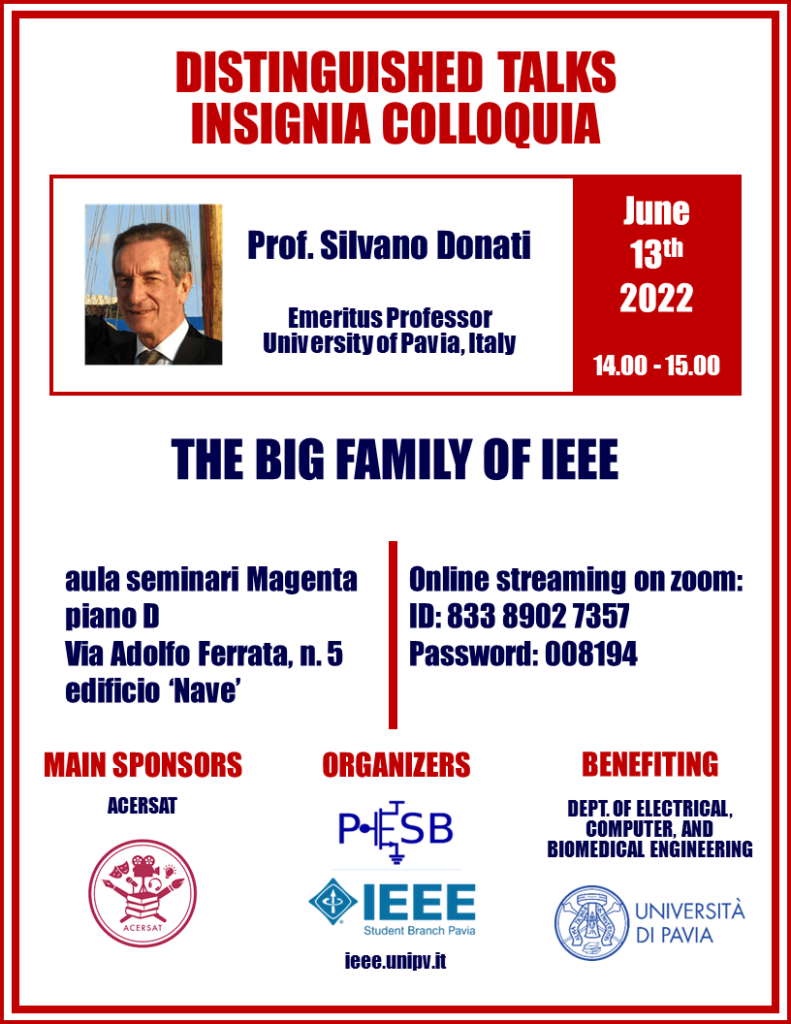
We are pleased to invite you to a webinar on The Big Family of IEEE held by Prof. Silvano Donati, Emeritus Professor at the University of Pavia and Counselor of our Student Branch. The event will take place on June 13th at 14.00 am in Magenta Seminar Room of the Faculty of Engineering and online.
Thank you and best wishes from the IEEE Student Branch of Pavia and PESB.The
Silvano Donati (M’75, SM’98, F’03, LF’09) has been Chair Professor of University of Pavia from 1980 to 2014, and became Emeritus in 2015. He has authored or co–authored 350+ papers and holds a dozen patents. He has authored two books, ‘Photodetectors’ and ‘Electro–Optical Instrumentation’. He has received several awards from the AEIT and IEEE, in particular the Marconi medal of AEIT, the Aaron Kressel Award and the Distinguished Service Award of the IEEE Photonics Society. He was the founding Chairman (1997) of the Italian LEOS Chapter, LEOS VP Region 8 Membership (2002–04) and Bo (2004– 06), and the Chairman of the IEEE Italy Section (2008–09). He has been Visiting Professor at several Universities of Taiwan. Prof. Donati is Life Member of SPIE, Life Fellow of the IEEE, and OSA Emeritus Fellow. See more at http://www.unipv.it/donati.
The IEEE is the largest scientific Society in the world, representing the scientific and Technical community of Electrical and Electronic and Computer Science engineers, totaling 400,000 members distributed almost equally among Universities, Research Centers and Companies. The IEEE publishes 180 scientific Journals and Magazines, runs 650 international conferences each year, and is present in virtually any Country of the world through a number of Section, Chapters, and Student Branches. In this talk a short history of the IEEE will be presented, starting from the pioneers Volta, Ampere, Faraday, Ohm, Maxwell, Pacinotti, and Marconi, to the Founders Edison and Bell, then to give an insight to the territorial and specialty organization, and to the Italy Section formed in 1958 by Mario Chou the inventor of the first Olivetti computer.
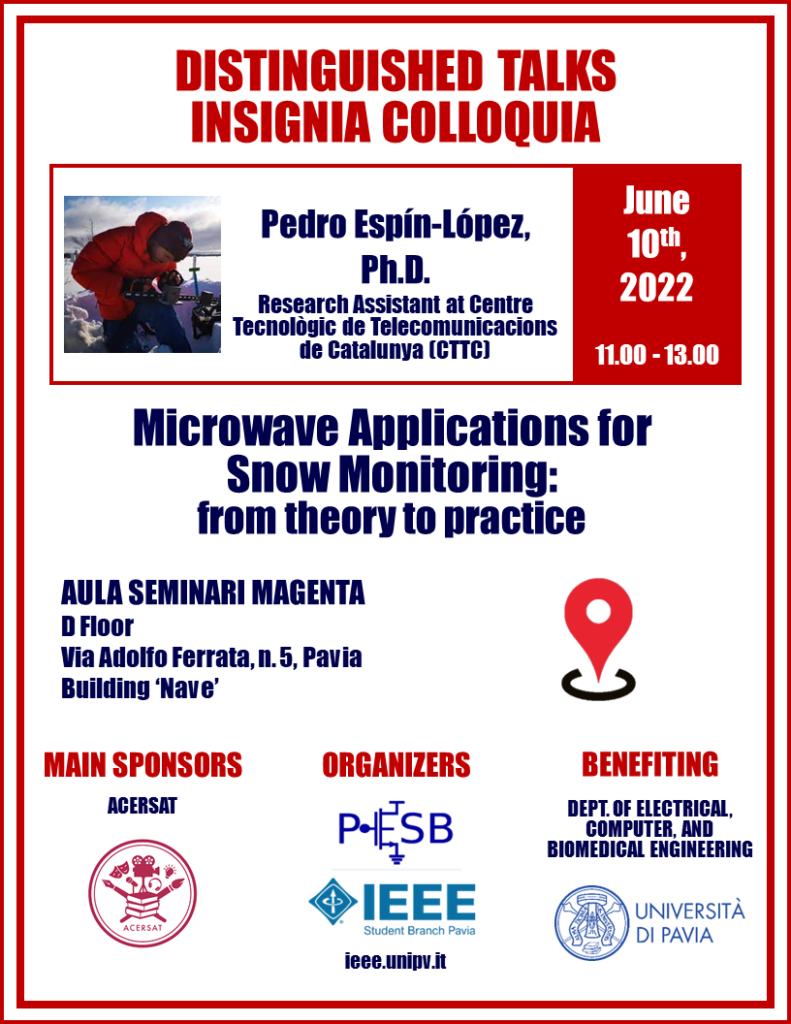
We are pleased to invite you to a webinar on Microwave Applications for Snow Monitoring: from theory to practice held by Pedro Fidel Espin Lopez, Ph.D., reserach assistant at Centre Tecnològic de Telecomunicacions de Catalunya (CTTC). The event will take place on June 10th at 11.00 am in Magenta Seminar Room of the Faculty of Engineering.
Thank you and best wishes from the IEEE Student Branch of Pavia and PESB.
Pedro Espín-López was born in Murcia, Spain, in 1989. He received the M.S. degree in electronic engineering from the Technical University of Cartagena, Spain, in 2015. During 2015-2016 he worked with the European Institute of Oncology (IEO) as research fellow. His work was focused on the study of non-ionizing dosimetry and the assessment of safety for a breast cancer detection system using millimetre and sub-millimetre waves. In 2020, he received the Ph.D. in electronics from the University of Pavia thanks to his research activities on the study and development of microwave and millimetre wave radar systems, paying special attention to the monitoring of the snow cover. Currently he is working at the Centre Tecnològic de Telecomunicacions de Catalunya (CTTC) as Research Assistant in the Geomatics Research Unit.
Snow is a very important environmental variable and a primary water resource in many areas of the world. Monitoring seasonal snowpack properties is crucial for properly managing snow-related hazards such as snow avalanches and snowmelt-floods. Microwave radars have been proposed as a mean to non-destructively monitor snowpacks, but they face several problems. From the electromagnetic point of view, snow is a complex material that can change its electromagnetic properties within seconds. Moreover, it is almost impossible to be studied inside a laboratory and some of the sites for studying the snow in good conditions can be hard-to-reach and with adverse meteorological conditions. All these aspects make the study of snow a real challenge. This seminar will focus on the techniques to study the snow using microwaves and how these techniques are applied in the field.
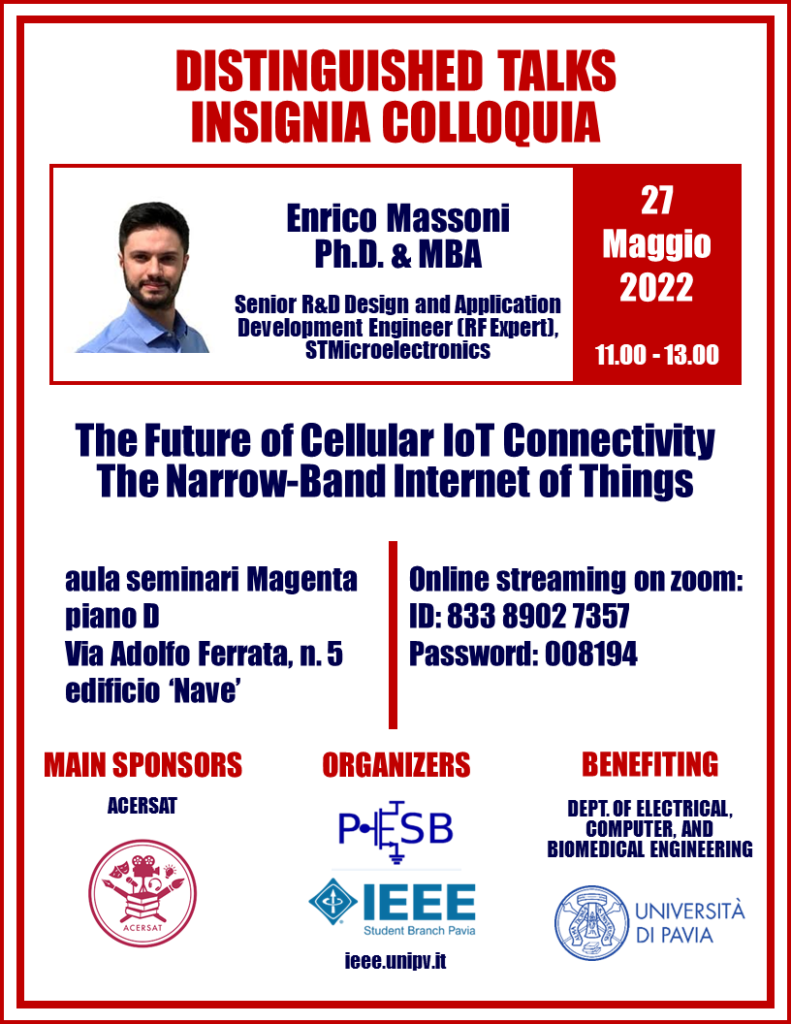
We are pleased to invite you to a webinar on The Future of Cellular IoT Connectivity – The Narrow-Band Internet of Things held by Enrico Massoni, Ph.D. & MBA, senior R&D design and application developement engineer (RF expert) at ST Microelectronics. The event will take place on May 27th at 11.00 am in Magenta Seminar Room of the Faculty of Engineering and online.
Thank you and best wishes from the IEEE Student Branch of Pavia and PESB.
Enrico Massoni (E.M.) was born in Broni (PV), Italy, on January 23th, 1991. Past graduate from the University of Pavia (BSc ‘13, MSc ‘15, Licensed Engineer ’16 and Ph.D. ‘18), Faculty of Engineering, Microwave Laboratory. E.M. lived abroad in Ghent, Flanders, Belgium (‘15) and Montréal, Québec, Canada (‘18). E.M. joined STMicroelectronics November ‘18, and he was appointed “Senior R&D Engineer (RF/Microwave Expert)”, inside Analog MEMS and Sensors Group. Afterwards, E.M. graduated from the “Collège des Ingénieurs” M.B.A. Alumni Class ’21. More recently, E.M. has been appointed Team/Programme Leader (NB-IoT Champion), inside IPC Division, AMS Group of STMicroelectronics. Active member of cultural and scientific associations like AEIT-AMES, IEEE and EuMA, E.M. is personally and professionally interested in cutting-edge engineering technologies, especially in the RF and Microwave fields, both with implications of innovation, industrialization and business opportunities.
The Narrow-Band Internet-of-Things (NB-IoT) is a standard-based low power wide area (LPWA) technology developed to enable a wide range of new IoT devices and services. NB-IoT significantly improves the power consumption of user devices, system capacity and spectrum efficiency, especially in deep coverage. Battery life of more than 10 years can be supported for a wide range of use cases. New physical layer signals and channels are designed to meet the demanding requirement of extended coverage and ultra-low device complexity. Supported by all major mobile equipment, chipset and module manufacturers, NB-IoT can co-exist with 2G, 3G, and 4G mobile networks. It also benefits from all the security and privacy features of mobile networks, such as support for user identity confidentiality, entity authentication, confidentiality, data integrity, and mobile equipment identification. Inside this scenario, an integrated passive device (IPD) solution is introduced. This IPD device implements a dedicated RF front-end (RF-FE) for Narrow-band Internet-of-Things (NB-IoT) modules. Adopting ST-proprietary IPD technology it is possible to integrate in a unique device several stand-alone RF functions. Specifically, a prototype embedding balun, low-pass filters and a coupler has been conceived, designed, and experimentally validated. In addition, this solution is highly versatile, providing compatibility with both the design of planar technology modules, molded modules and stacked modules, making it attractive for the implementation of the future generation of radio modules.

We are pleased to invite you to a webinar on Self-Mixing Interferometry: a universal yardstick to measure almost everything held by Prof. Silvano Donati, Emeritus Professor at the University of Pavia and Counselor of our Student Branch. The event will take place on May 12nd at 11.00 am in Magenta Seminar Room of the Faculty of Engineering and online.
Thank you and best wishes from the IEEE Student Branch of Pavia and PESB.The
Silvano Donati (M’75, SM’98, F’03, LF’09) has been Chair Professor of University of Pavia from 1980 to 2014, and became Emeritus in 2015. He has authored or co–authored 350+ papers and holds a dozen patents. He has authored two books, ‘Photodetectors’ and ‘Electro–Optical Instrumentation’. He has received several awards from the AEIT and IEEE, in particular the Marconi medal of AEIT, the Aaron Kressel Award and the Distinguished Service Award of the IEEE Photonics Society. He was the founding Chairman (1997) of the Italian LEOS Chapter, LEOS VP Region 8 Membership (2002–04) and Bo (2004– 06), and the Chairman of the IEEE Italy Section (2008–09). He has been Visiting Professor at several Universities of Taiwan. Prof. Donati is Life Member of SPIE, Life Fellow of the IEEE, and OSA Emeritus Fellow. See more at http://www.unipv.it/donati.
Self-mixing interferometry is a coherent technique for measurement of dimensional and kinematic quantities such as: displacement, distance, vibration amplitude, thickness, angle, and curvature, and of physical quantities like: coupling factors, line width, alfa-factor, and index of refraction. In the measurement arrangement, the laser undergoes self-injection at weak level, leading to AM and FM driven by external optical path length. We report on the development of a displacement-measuring instrument, based on up/down counting of mode hops, and then extend the measurement to the practical case of a diffuse (non-cooperative) target, covering displacements up to 1-m with um-resolution. For sub-um vibrations, we implement a two-channel vibrometer based on analogue processing, removing amplitude errors thanks to a servo-loop. For the first time, we report non-contact measurement of the mechanical frequency response and, even more unusual, hysteresis cycle (or the stress/strain diagram) of a sample under test. Additionally, a number of surprising measurements performed by self-mix will be finally surveyed, i.e., the absolute distance meter, the thickness, angles and return echoes measurements as well as that of laser parameters like linewidth and alpha-factor.
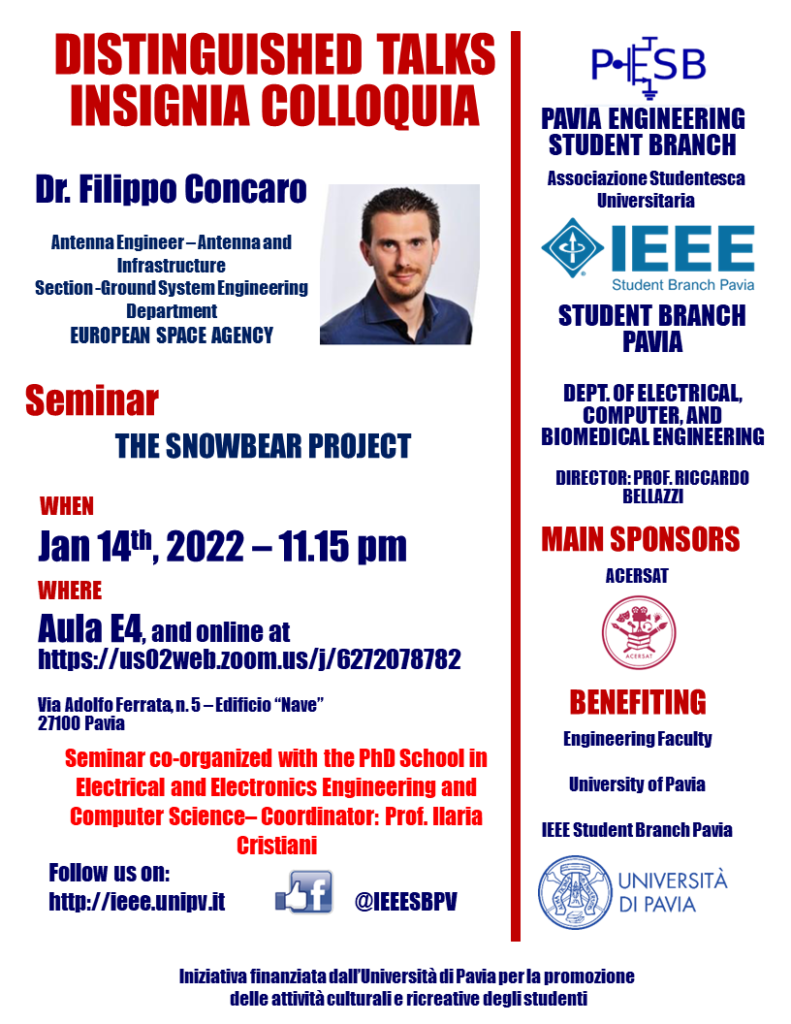
We are pleased to invite you to a webinar on The SNOWWBEAR Project held by Dr. Filippo Concaro, Antenna Engineer at the European Space Agency. The event will take place on January 14th at 11.15 am in Room E4 of the Faculty of Engineering and online.
Thank you and best wishes from the IEEE Student Branch of Pavia and PESB.The
Filippo Concaro was born in Tortona, Italy, in 1979. He received the “Laurea” degree in Electronic Engineering from the University of Pavia, Italy, in 2003, with a Thesis on “Analysis and Synthesis of the Beam Waveguide System of ESA Deep Space Antenna 2” after a 6-months traineeship in the Ground Station Antenna (GSA) Section at the European Space Operation Centre (ESOC) in Darmstadt (Germany). Since then has been always working in ESOC, despite a parenthesis of 14 months at the European Organization for the Exploitation of Meteorological Satellites (EUMETSAT), also located in Darmstadt. During all these years he was involved in the design and testing of several Ground Station projects all over the European Space Agency Tracking Network (ESTRACK). In particular he was Technical Officer of various projects such the so-called XAA (X-Band acquisition Aid) terminals deployed in Perth (Australia), Kourou (French Guyana) and Maspalomas (Canary Islands), the NNO-2 antenna in New Norcia (Australia) the MAL-X in Malindi (Kenia) and the SNOWBEAR at Svalbard (Norway), he is also responsible for the deployment of the Brand new cryo feed systems into the ESA Deep Space antennas (Spain and Argentina) and deputy TO of the new NNO-3 Deep Space Antenna project.
The SNOWBEAR project (Svalbard grouNd StatiOn for Wide Band Earth observation dAta Reception) was a study project by the European Space Agency (ESA) aimed to de-risk the introduction of the new 26 GHz frequency band for payload data reception of the future Earth Observation Mission. It consisted in the deployment of a prototype ground station at Svalbard (completed in autumn 2018) and a two-years operational trial using the Earth Observation satellite NASA/NOAA JPSS-1 (completed in autumn 2020). The analysis of the study results, performed in ollaboration with the University of Pavia, was very helpful to characterize the impairments due to rain and snow accumulation on the antenna radome at high frequencies.
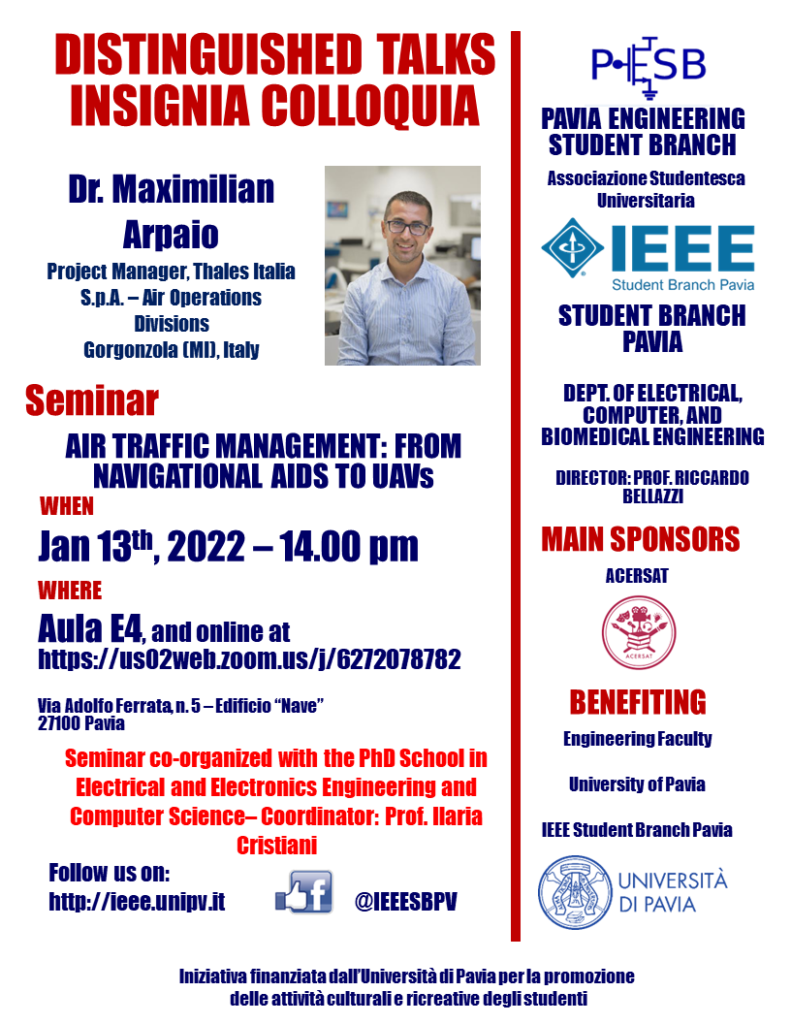
We are pleased to invite you to a webinar on Air Traffic Management: from navigational aids to UAVs held by Dr. Maximilian Arpaio, Project Manager at Thales Italia. The event will take place on January 13th at 2.00 pm in Room E4 of the Faculty of Engineering and online.
Thank you and best wishes from the IEEE Student Branch of Pavia and PESB.The
Maximilian Arpaio received the Master degree in Telecommunications Engineering from the University of Parma in 2005 with a Thesis on DAB antennas. In 2007 he got a specialization in Wind Engineering at the Faculty of Aerospace Engineering of the Polytechnic of Milan, studying the effects of the wind on blunt bodies for antennas arrays. In 2012 he received his Post graduate Master in Project Management from the Faculty of Economics of the University of Verona with a Thesis on Multicultural Projects. Finally, in 2021 he obtained his PhD in Electronic Engineering, Telecommunications and Information Technologies at the Alma Mater Studiorum University of Bologna, carrying out research activities in the field of antennas and propagation in relation to 5G and drones. On a professional level, after a short period of research at University, from 2006 to 2008 he worked at the Telecomunicazioni Aldena company in Milan as technical engineer for radio-television transmission systems, as well as designer of passive RF / MW components and antenna systems engineer. In 2008 he joined Thales group, within the Air Operations Division, Navigation and Airport Solutions. In this period he worked in Milan as a project and system engineer for new generation surveillance systems and conventional air navigation aids, with particular reference to Multilateration and ADS-B technologies. Since mid-2011 he joined the Project Management Department, where he currently manages with a Senior profile civilian and military international projects with a special imprint on strong technological innovation components. His current interests are focused on antennas and RF propagation within different environments. He has been collaborating for many years with various Italian universities by promoting technical seminars and scientific collaborations.
Global air traffic has grown steadily since 2003. To adapt air traffic management infrastructure to
future demand, civil and militar aviation authorities need to upgrade their current systems to develop new applications. In response to increasing air traffic volumes at the busiest airports, Thales group developed an integrated gate-to-gate solution that encompasses the en-route, approach and airport phases. To better address the lecture thorugh the above path, the main navigation aids will be thus shown and explained including their principles of operation, with a special enphasis on their strenghts as well as on their current weak points. Technological innovations that are advancing on the market will be then introduced, with a special focus on systems that are based on GNSS technology like ADS-B, Multilateration and GBAS. For some of them, the main implementation issues of operation will be discussed as well as with some practical cases. The seminar will close with some thoughts on the future technologies as applied to current air navigation aids in the frame of the current pandemic situation and the rise of UAVs.
